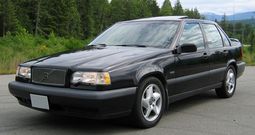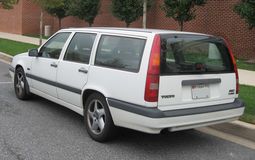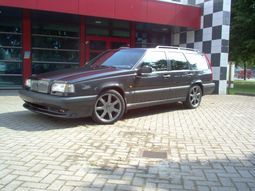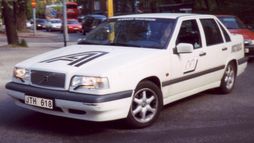The History Of Volvo 850

The Volvo 850 is a compact executive car produced by Volvo Cars from 1992 to 1997 (sold as 1993–1997 in the U.S. market) and designed by Jan Wilsgaard. Available in sedan/ saloon and station wagon/ estate body styles, the Volvo 850 was notable as the first front-wheel drive vehicle from this Swedish manufacturer to be exported to North America. It is often considered the vehicle that gave Volvo its reputation as a high-end auto maker in North America due to the level of features available in this model that were not offered in previous models. At the time of its development, the 850 was regarded as one of the largest engineering endeavours in Sweden.
The Volvo 850 was introduced worldwide as a 1992 model, but arrived in the U.S. in the 1993 model year. It was sold as a sedan with a wagon model on sale from 1992 in Europe. The 850 was the first Volvo model in the U.S. to feature front-wheel drive and an all-aluminum 20-valve five-cylinder engine. The 850 was Volvo's top-seller in the mid-1990s. In markets outside the U.S. a 10-valve variant of the five-cylinder was popular for its lower cost and better fuel economy.
All U.S. 850s received standard equipment such as dual front airbags, antilock brakes, head restraints and three-point seat belts for all passengers, power windows, door locks, and mirrors, cruise control, and dual zone climate control. Side torso airbags became a world first when introduced as an option for 1995. Some other options during the model run included features such as traction control, leather interior, power glass moonroof, power seats, heated seats, remote keyless entry, automatic climate control, and automatic transmission.
The 850 sedan features a remarkable interior space of 2.80m³ (99cubic ft). This is slightly more than the 2.78m³ (98cubic ft) of the 2004 Mercedes-Benz E-Class even though the car is reasonably compact on the outside. This space is achieved by mounting the in-line 5-cylinder engine transversely (from the left to the right of the car) under the hood. The road-holding and handling are vastly improved over the previous rear-wheel drive Volvos.
The 850 Turbo Wagon is one of the fastest production station wagons in the world, capable of 250+ km/ h (160+ mph) when ungoverned.[citation needed] Production models of the wagon and sedan are electronically governed to approximately 142mph (229km/ h).[citation needed] In 1996 a "Platinum" edition of the 850 Turbo was available. The exterior paint for these models came in a metallic pearl platinum-color and had special 16-inch (410mm) alloy wheels. The interior was fitted with leather seats and burled walnut accents. Only 1500 of these were imported for the U.S. market.
For the last model year (1996/ 1997) 850 was available also with 5-cylinder Volkswagen/ Audi turbodiesel engine (D5252T) with 140bhp (104kW; 142PS). As well AWD (All Wheel Drive) model was introduced with a new 193bhp (144kW; 196PS) low pressure turbo 2.4 litre engine (B5254T).
In 1998, the model line was updated, and renamed the Volvo S70 (sedan) and Volvo V70 (station wagon). These vehicles were sold in the U.S. through the 2000 model year when there were still many 850's waiting to be sold. This allowed for an alternatively designed vehicle; the 2001 Volvo S60 and Volvo V70, during the 850's production hiatus.
For the 850, Volvo created what it called "Delta-link semi-independent rear suspension". Volvo held a U.S. patent for rear axle bushings that compress under load, giving the Volvo 850 passive rear steering. The automobile also has a tight turning circle, 10.2m (33.5ft), and was considered very maneuverable. By comparison, later large Volvos had a 11.9m (39.0ft) turning circle.
Legendary Australian race driver Peter Brock drove a Volvo 850 touring car in a one-off Bathurst 12-hour endurance event in 1994, and drove the car in the 1996 Australian Super Touring Championship. Volvo joined forces with the famous and very successful Tom Walkinshaw Racing team (TWR) in 1994 to build an 850 Estate touring car to compete in the British Touring Car Championship (BTCC). Despite much criticism, the 850 Estate performed well, with a best placed finish of fifth, and a best qualifying spot of third. It was driven by Rickard Rydell and Jan Lammers and Volvo finished sixth in manufacturers' standings in the 1994 season. In 1995, TWR and Volvo built the 850R Saloon BTCC Racer and this won five races, qualified on pole position 13 times with Rickard Rydell and Tim Harvey and finished third in the championship. The switch was due mainly to the change in BTCC regulations which allowed aerodynamic aids (spoilers) which effectively ended any chance of the Estate being fully competitive. In 1996, an improved 850R saloon raced which boasted eight wins with Rickard Rydell and Kelvin Burt and finished third in the championship. Volvo were also prevalent with the 850 in championships across Europe and in Australia.
In 1995 a special limited edition race-bred model was released. This "850 T-5R" model was limited in exterior paint color choices: only available in cream yellow (2500 worldwide including sedan and station wagon), in black (2500 worldwide including sedan and station wagon) and emerald green metallic (500 worldwide including sedan and station wagon). Only 2,000 were made for the U.S. market and in only two colours, black and creme yellow. There were 1,825 of them in black and 185 of the cream yellow models. The vehicle was based upon the 850 Turbo with the B5234T5 engine with a special ECU known as the Bosch #628 ECU, that added 3psi (21kPa) to turbocharger boost pressure, giving the engine an additional 18horsepower (13kW).
1995 was the only year that the race-bred model was badged as a "T-5R". All subsequent models are badged with just the simple addition of "R". Example: 1995 850 T-5R, 1996 850R, 1997 850R, 2004 S60R, etc.
For the Italian market, the T-5R was based on the 2.0 litre 850 Turbo. The transmission was the standard AW/ 50-42 used in all U.S. 850's, the M56H being available in other countries.
Also, included in the 1995 "T-5R" package is a front bumper with a lip, and a special Alcantara (the fire-retardant version of Toray Industries' Ultrasuede (tm)) and leather two-tone interior, in dark grey with deep birch wood grain accents. Additionally, the 1995 "T-5R" models came with polished aluminum door sills and for the 1995 model year only, the "T-5R" had an additional badge to the left of the "850" on the trunk, referred to as "The Motorsport badge". Aftermarket Motorsport badges are available and are often added by owners but only the 1995 T-5R came standard with that badge. The standard wheels were the 5-spoke 17×7 "Titan". The 1995 "T-5R" had a very limited production run. For the U.S. market there were only 2,000 produced and they only came in two colours, black and creme yellow. The creme yellow were the rarer of the two with only 185 produced out of the 2,000 shipped to the U.S. With the age of the "T-5R" and the fact that they appeal to more aggressive drivers the number still on the road has shrunk.
In 1996 and continued through 1997 (the final year of the 850) a separate R model was released called the "850 R", this model was not as limited in production as the "T-5R" was. Monza red, black, anthracite grey, emerald green metallic, turquoise and white were the only color choices. Also, a new rear spoiler on sedans was introduced, and the interior was still two-tone but, the layout changed — in 1995 the leather was in the center of the seats — now it was on the outside bolster portion. The standard wheels used in these model years were the 17×7 "Volans". For 1996 and 1997, Volvo also introduced a new manual transmission for these cars called the M59 that came standard with a Torsen differential. The M59 was available in most markets, except the US. Furthermore, the M59 cars were equipped with a slightly larger turbocharger, the TD04H-16T, and upgraded software enabling these cars to produce 250hp (190kW) versus 240hp (180kW) for the automatic transmission equipped cars. Torque was also significantly increased in the manual models from 300N·m (220lb·ft) to 350N·m (260lb·ft).
All manufacturer's suggested retail prices (MSRPs) are base prices only.
1993
- 850 GLT ($24,800 MSRP): 2.4L I5, 168hp (125kW) @ 6300rpm and 162ft·lbf (220N·m) @ 4500rpm
All 1993 850 models were badged GLT, regardless of equipment. Many options (leather, sunroof, and more) were bundled into the Touring package.
1994
- 850 ($24,300 MSRP): 2.4L I5, 168hp (125kW) @ 6300rpm and 162ft·lbf (220N·m) @ 4500rpm
- 850 Turbo ($29,985 MSRP): 2.3L I5, 222hp (166kW) @ 5200rpm and 221ft·lbf (300N·m) @ 2100rpm
The base 850 sedan includes the same headlights, front valance and front and rear bumper as the 1993 850, while all other models, including the new wagon, get revised headlights, front valances, and front and rear bumpers. The GLT badge is dropped, although all the same equipment is available. The 222hp (166kW) Turbo sedan and wagon, as well as the normally aspirated 168hp (125kW) wagon, are new models this year.
1995
- 850 ($24,580 MSRP): 2.4L I5, 168hp (125kW) @ 6300rpm and 162ft·lbf (220N·m) @ 4500rpm
- 850 GLT ($27,110 MSRP): 2.4L I5, 168hp (125kW) @ 6300rpm and 162ft·lbf (220N·m) @ 4500rpm
- 850 Turbo ($31,045 MSRP): 2.3L I5, 222hp (166kW) @ 5200rpm and 221ft·lbf (300N·m) @ 2100rpm
- 850 T-5R ($35,545 MSRP): 2.3L I5, 240hp (179kW) @ 5600rpm and 221ft·lbf (300N·m) @ 2100rpm
The GLT badge returned for the 1995 model year, so there were now sedan and wagon versions of the 850, 850 GLT, 850 Turbo, and 850 T-5R. The T-5R was the new high performance model, with more power stemming from ECU tuning, and special suspension, trim and wheels. In addition to the introduction of the T-5R, changes included new tail-lights for sedans, optional side airbags, new interior switch-gear design and several other detail changes.
1996
- 850 ($26,125 MSRP): 2.4L I5, 168hp (125kW) @ 6300rpm and 162ft·lbf (220N·m) @ 4700rpm
- 850 GLT ($29,200 MSRP): 2.4L I5, 168hp (125kW) @ 6300rpm and 162ft·lbf (220N·m) @ 4500rpm
- 850 Turbo ($32,650 MSRP): 2.3L I5, 222hp (166kW) @ 5200rpm and 221ft·lbf (300N·m) @ 2100rpm
- 850 R ($37,925 MSRP): 2.3L I5, 240hp (179kW) @ 5600rpm and 221ft·lbf (300N·m) @ 2100rpm
Changes this year include a revised power door lock system, new exterior colors, and full OBD-II compliance. The T-5R high performance version became the R in 1996, but the performance differences remained relatively the same.
1997
- 850 ($26,710 MSRP): 2.4L I5, 168hp (125kW) @ 6300rpm and 162ft·lbf (220N·m) @ 4500rpm
- 850 GLT ($31,835 MSRP): 2.4L I5, 190hp (142kW) @ 5100rpm and 199ft·lbf (270N·m) at 1600rpm
- 850 T-5 ($34,500 MSRP): 2.3L I5, 222hp (166kW) @ 5200rpm and 221ft·lbf (300N·m) @ 2100rpm
- 850 R ($38,685 MSRP): 2.3L I5, 240hp (179kW) @ 5600rpm and 221ft·lbf (300N·m) @ 2100rpm
For 1997, the 850's final year, all GLT models were increased to 190hp (142kW) by pairing a low-pressure turbocharger with the 2.4L engine. The 850 Turbo model was thence called the 850 T-5, as it always had been in the UK. The 1997 model year was short, as the substantially similar (virtually identical except for superficial styling changes) Volvo S70 sedan and Volvo V70 wagon were introduced during the first half of 1997.
Quick Info
From Wikipedia, the free encyclopedia
More About Volvo 850




|